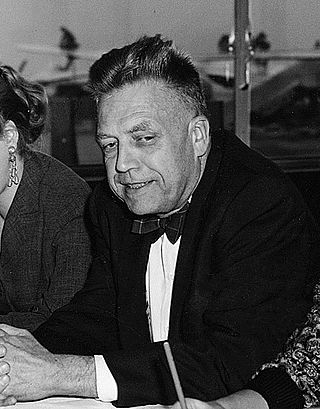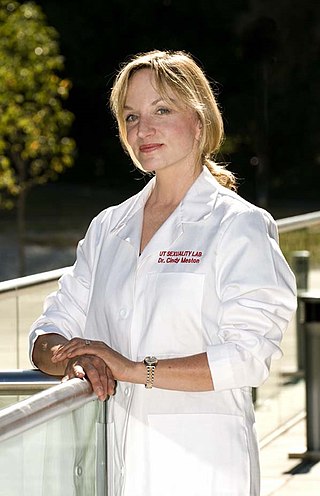Related Research Articles

Human sexual activity, human sexual practice or human sexual behaviour is the manner in which humans experience and express their sexuality. People engage in a variety of sexual acts, ranging from activities done alone to acts with another person in varying patterns of frequency, for a wide variety of reasons. Sexual activity usually results in sexual arousal and physiological changes in the aroused person, some of which are pronounced while others are more subtle. Sexual activity may also include conduct and activities which are intended to arouse the sexual interest of another or enhance the sex life of another, such as strategies to find or attract partners, or personal interactions between individuals. Sexual activity may follow sexual arousal.

Orgasm or sexual climax is the sudden discharge of accumulated sexual excitement during the sexual response cycle, resulting in rhythmic, involuntary muscular contractions in the pelvic region characterized by sexual pleasure. Experienced by males and females, orgasms are controlled by the involuntary or autonomic nervous system. They are usually associated with involuntary actions, including muscular spasms in multiple areas of the body, a general euphoric sensation and, frequently, body movements and vocalizations. The period after orgasm is typically a relaxing experience, attributed to the release of the neurohormones oxytocin and prolactin as well as endorphins.

Alfred Charles Kinsey was an American sexologist, biologist, and professor of entomology and zoology who, in 1947, founded the Institute for Sex Research at Indiana University, now known as the Kinsey Institute for Research in Sex, Gender, and Reproduction. He is best known for writing Sexual Behavior in the Human Male (1948) and Sexual Behavior in the Human Female (1953), also known as the Kinsey Reports, as well as for the Kinsey scale. Kinsey's research on human sexuality, foundational to the field of sexology, provoked controversy in the 1940s and 1950s, and has continued to provoke controversy decades after his death. His work has influenced social and cultural values in the United States as well as internationally.

The Kinsey scale, also called the Heterosexual–Homosexual Rating Scale, is used in research to describe a person's sexual orientation based on one’s experience or response at a given time. The scale typically ranges from 0, meaning exclusively heterosexual, to a 6, meaning exclusively homosexual. In both the male and female volumes of the Kinsey Reports, an additional grade, listed as "X", indicated "no socio-sexual contacts or reactions" (asexuality). The reports were first published in Sexual Behavior in the Human Male (1948) by Alfred Kinsey, Wardell Pomeroy, and others, and were also prominent in the complementary work Sexual Behavior in the Human Female (1953).

The missionary position or man-on-top position is a sex position in which, generally, a woman lies on her back and a man lies on top of her while they face each other and engage in vaginal intercourse. The position may also be used for other sexual activity, such as anal sex. It is commonly associated with heterosexual sexual activity, but is also used by same-sex couples.

The Kinsey Institute for Research in Sex, Gender, and Reproduction is a research institute at Indiana University. Established in Bloomington, Indiana, in 1947 as a nonprofit, the institute merged with Indiana University in 2016, "abolishing the 1947 independent incorporation absolutely and completely."
The Masters and Johnson research team, composed of William H. Masters and Virginia E. Johnson, pioneered research into the nature of human sexual response and the diagnosis and treatment of sexual disorders and dysfunctions from 1957 until the 1990s.
Dr John H.J. Bancroft is a physician who was Director of The Kinsey Institute for Research in Sex, Gender, and Reproduction at Indiana University from 1995 to 2004. He was a Clinical Professor of Psychiatry at Indiana University School of Medicine.

A sexual fantasy or erotic fantasy is a mental image or pattern of thought that stirs a person's sexuality and can create or enhance sexual arousal. A sexual fantasy can be created by the person's imagination or memory, and may be triggered autonomously or by external stimulation such as erotic literature or pornography, a physical object, or sexual attraction to another person. Anything that may give rise to a sexual arousal may also produce a sexual fantasy, and sexual arousal may in turn give rise to fantasies.

Shere Hite was an American-born German sex educator and feminist. Her sexological work focused primarily on female sexuality. Hite built upon biological studies of sex by Masters and Johnson and by Alfred Kinsey. She also referenced theoretical, political and psychological works associated with the feminist movement of the 1970s, such as Anne Koedt's essay The Myth of the Vaginal Orgasm. She renounced her United States citizenship in 1995 to become German.
John H. Gagon was one of the sociologists who developed the breath of research available on human sexuality.

Masturbation is the sexual stimulation of one's own genitals for sexual arousal or other sexual pleasure, usually to the point of orgasm. The stimulation may involve hands, fingers, everyday objects, sex toys such as vibrators, or combinations of these. Mutual masturbation is masturbation with a sexual partner, and may include manual stimulation of a partner's genitals, or be used as a form of non-penetrative sex.

Lesbian sexual practices are sexual activities involving women who have sex with women, regardless of their sexual orientation. A woman who has sex with another woman may identify as a lesbian if she is sexually attracted to women, or bisexual if she is not exclusively sexually attracted to women, or dispense with sexual identification altogether. The term may also be applied to a heterosexual or asexual woman who is unsure of or is exploring her sexuality.

Human female sexuality encompasses a broad range of behaviors and processes, including female sexual identity and sexual behavior, the physiological, psychological, social, cultural, political, and spiritual or religious aspects of sexual activity. Various aspects and dimensions of female sexuality, as a part of human sexuality, have also been addressed by principles of ethics, morality, and theology. In almost any historical era and culture, the arts, including literary and visual arts, as well as popular culture, present a substantial portion of a given society's views on human sexuality, which includes both implicit (covert) and explicit (overt) aspects and manifestations of feminine sexuality and behavior.
Anke A. Ehrhardt is a researcher in the field of sexual and gender development of children, adolescents, and adults. Her research has included a wide range of studies on determinants of sexual risk behavior among children, adolescents, heterosexual women and men, and the gay population, and on comprehensive approaches to preventing HIV and STD infection. Ehrhardt is the Founding Director of the HIV Center for Clinical and Behavioral Studies at the New York State Psychiatric Institute and Columbia University, where she has had a particular focus on research and advocacy for female-controlled methods of HIV prevention.
Joseph LoPiccolo is an American psychologist and sex researcher who focuses on female sexual response. He coauthored the self-help book Becoming Orgasmic with Julia Heiman and served on the Subcommittee on Sexual Dysfunctions for the DSM-III-R. He is Professor Emeritus of Psychological Sciences at the University of Missouri in Columbia, Missouri, where previously served as chair of the department.
Leonore Tiefer is an educator, researcher, therapist, and activist specializing in sexuality, and is a public critic of disease mongering as it applies to sexual life and problems.
June Machover Reinisch is an American psychologist who has helped advance the public's general knowledge of human sexual activity. From 1982 to 1993, she was director of the Kinsey Institute at Indiana University. Her research at the Institute focused on sexual and psychosexual development. She has published more than 100 scientific papers in such journals as Science, Nature, JAMA, American Psychologist, Hormones and Behavior, MMWR, JPSP, Archives of Internal Medicine, and the British and American Journals or Psychiatry.

Cindy Meston is a Canadian-American clinical psychologist well-known for her research on the psychophysiology of female sexual arousal. She is a Full Professor of Clinical Psychology at the University of Texas at Austin, Director of the Female Sexual Psychophysiology Laboratory, and author of Why Women Have Sex. In 2016, the BBC, London, England named Meston one of the 100 most influential and inspirational women in the world.
The orgasm gap, or pleasure gap, is a social phenomenon referring to the general disparity between heterosexual men and women in terms of sexual satisfaction—more specifically, the unequal frequency in achievement of orgasm during sexual encounters. Currently, across every demographic that has been studied, women report the lowest frequency of reaching orgasm during sexual encounters with men. Researchers speculate there are multiple factors that may contribute to the orgasm gap. Orgasm gap researcher Laurie Mintz argues that the primary reason for this form of gender inequality is due to "our cultural ignorance of the clitoris" and that it is commonplace to "mislabel women's genitals by the one part that gives men, but not women, reliable orgasms."
References
- ↑ Kinsey Institute (2007). Julia Heiman, Ph.D. Retrieved from http://www.kinseyinstitute.org/about/heiman2.html.
- ↑ Rose, Charlie (2007-11-20). Charlie Rose Science Series: Human Sexuality. Charlie Rose Show , 20 November 2007. Retrieved from http://www.charlierose.com/view/interview/8786.
- ↑ Kate Murphy (January 21, 2012). "Julia Heiman". New York Times.
- ↑ Heiman, Julia R. (2010-08). Curriculum Vitae: Julia R. Heiman, Ph.D. August 2010. Retrieved from "Archived copy" (PDF). Archived from the original (PDF) on 2011-07-22. Retrieved 2011-06-07.
{{cite web}}: CS1 maint: archived copy as title (link). - 1 2 Biography and Genealogy Master Index. Farmington Hills, Mich.: Gale, Cengage Learning. 1980-2011.
- ↑ Kinsey Institute (2011). Julia Heiman. Retrieved from http://www.kinseyinstitute.org/about/heiman.html.